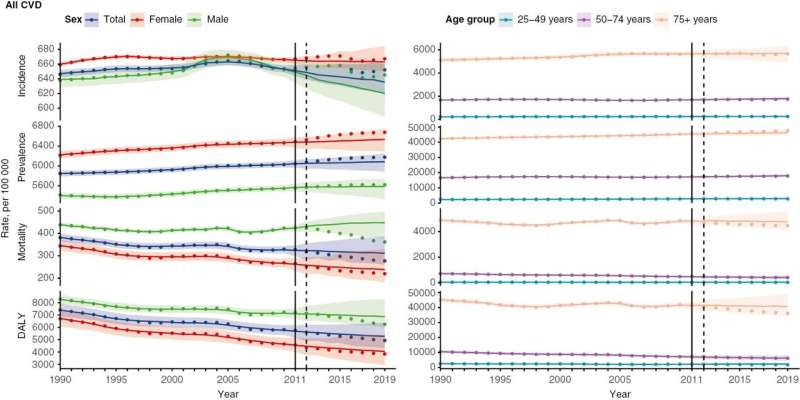- The American Heart Association has released a new advisory regarding a new type of condition related to heart, kidney and metabolic disorders.
- Health experts are referring to this as cardiovascular-kidney-metabolic (CKM) syndrome.
- The advisory includes updated approaches to screening, stages and treatment.
Heart disease has long been linked to other chronic conditions including
Now, officials from the American Heart Association (AHA) say in some cases, these connected conditions can be defined as a new syndrome called cardiovascular-kidney-metabolic syndrome or CKM.
Health experts have long noted connections between cardiovascular disease among obesity, type 2 diabetes, and chronic kidney disease.
AHA officials published the advisory in the journal
“The advisory addresses the connections among these conditions with a particular focus on identifying people at early stages of CKM syndrome,” said Dr. Chiadi E. Ndumele, M.D., Ph.D., M.H.S., FAHA, co-author and an associate professor of medicine and director of obesity and cardiometabolic research in the division of cardiology at Johns Hopkins University in Baltimore said in a
The AHA has released a presidential advisory in the hopes that healthcare providers can help people more effectively treat CKM.
The advisory includes information about the stages of the disease and potential causes.
The advisory includes:
- The 4 stages of CKM syndrome starting from Stage 0 (no risk factors) to Stage 4 (multiple risk factors).
- Screening for and addressing societal factors that could put people at increased risk.
- Encouraging physicians across different specialties to work in tandem to help a patient with CKM.
Additionally, the AHA recommends physicians review the risk calculator for heart attack and stroke that can help predict who is most at risk for these cardiac events. They propose the new algorithm offer heart attack and stroke estimates at the 10 year and 30 year mark.
One reason the AHA is releasing this advisory is in the hopes that more people can get access to better treatment.
“This advisory is very timely and includes important changes to incorporate a new model where we think more about the risk factors,” Dr. Dennis Bruemmer, doctor of cardiovascular medicine at the Cleveland Clinic, told Healthline. “The guidelines have shifted to a more preventative care approach which I think is important. It’s steering away from being a reactive model system to a more proactive system where we look at individual risk factors and how to treat risk factors earlier which ultimately will prevent complex diseases.”
Bruemmer was not part of the advisory committee.
When screening for and addressing social factors that impact health and CKM risk, physicians can consider issues such as economic stability, access to health care, and education level.
“These are very important for us to consider when we treat patients,” said Bruemmer. “For example, when we encounter a patient who has diabetes, we have to put this into the overall context in the life of the patient – economics, insurance, environmental factors and so on. All of these social determinants affect the care that we provide.”
Dr. Rohan Khera, Director of the Cardiovascular Data Science (CarDS) Lab at Yale School of Medicine explained that this advisory reflects the reality of clinical practice.
“Physicians have been aware that things don’t live in isolation, and a lot of our cardiovascular risk factors can be concurrent with metabolic risk factors and kidney risk factors,” said Khera. “So people who have cardiovascular disease frequently have metabolic challenges and chronic kidney disease.”
Khera continued: “From our perspective, we’ve always recognized that those things tracked together, and therefore we needed to think about these patients in a more holistic fashion. But it’s never been reflected in our clinical guidelines.”
Khera agreed social factors play a major role.
“We’ve recognized over the past several decades that poverty, lack of access to education, health literacy – these social determinants of health that pervade diet and lifestyle decisions – can cause people to be at high risk compared to others of the same age and sex,” Khera stated. “And we know that underrepresented racial and ethnic groups bear an excessive burden from these social determinants of health, which contributes to worse heart- and kidney-related outcomes.”
Another main focus of the advisory is ensuring that physicians are in contact across specialties so a cardiologist will talk to nephrologist or a physician who specializes in kidney care. To help person with CKM multiple physicians may be needed including a primary care physician, cardiologist and endocrinologist, all bringing their expertise to the table.
“Collaborative care means that we recognize the importance of working within a system of specialists,” Bruemmer stated. “Now, we have evidence from clinical studies that have studied collaborative care approaches and have seen that it is effective when doctors work together to manage these risk factors.”
Looking at these diseases from a holistic perspective is crucial.
“It’s predominantly about making sure there is collaboration across community health, primary care and specialty care providers,” said Khera. “The theme I’m seeing emerge is that we need to think of these diseases, and their risk drivers, in a more holistic way. Redefining the way we think about disease management by taking social factors into account.”
Understanding risk is important to develop an effective treatment plan for people with these conditions.
“When we sit with a patient in the office and talk about the future of their health, we don’t have a crystal ball but we like to assess the risk,” said Breummer. “If a person has a higher risk we can implement more aggressive preventive care strategies that will lower the future risk for heart attack, stroke, and diabetes. It is important to convey this to the patient because if they know their risk if higher they are likely going to be more motivated to change.”
Khera explained patients should be asking whether they have features or markers that actually put them at a higher risk in the future.
“We’ve done a lot of assessments of risk factors over the years and over the last 5 to 8 years, we’ve seen a move toward more quantitative ways of describing risk,” Khera stated. “Not just a particular risk factor, or saying you’re high-risk or low-risk, but combining risk factors to compute someone’s actual risk for developing a disease over the next five years. That information can help develop personalized lifestyle and treatment plans to manage that risk.”
If you’re concerned you have signs of heart, kidney or metabolic disease, you can talk to your physician about risk factors.
According to Breumer, top four indicators of health can include:
- Their weight and body mass index (BMI)
- Blood pressure level
- Lipids (cholesterol)
- Hemoglobin A1C (blood sugar levels)
Officials from the American Heart Association say that multiple chronic conditions can be defined as a new syndrome called cardiovascular-kidney-metabolic syndrome or CKM.
The advisory noted a connection between cardiovascular disease, obesity, Type 2 diabetes and chronic kidney disease, known as cardiovascular-kidney-metabolic (CKM) syndrome.
Revised recommendations for screening, stages and treatment are included.
Health experts confirm a collaborative model ensures optimal patient care.






